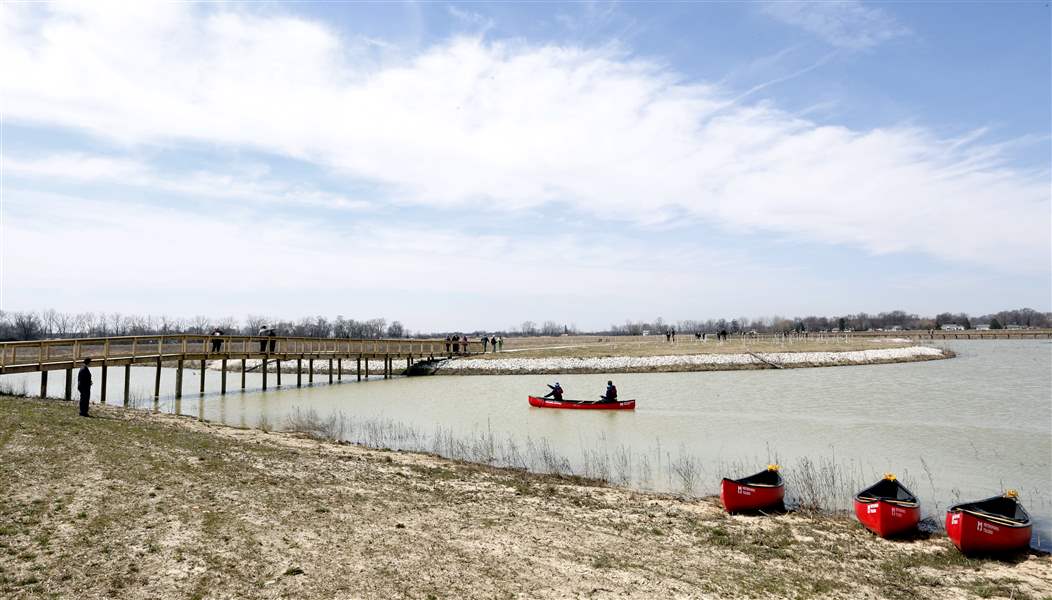
Howard Marsh Metropark opens to the public Saturday
4/23/2018
People walk along the Madewell Trail while a canoe is on the water during the dedication of Howard Marsh Metropark in Curtice on April 23, 2018.
The Blade/Amy E. Voigt
Buy This Image
Calling the new Howard Marsh Metropark a “giant jewel on a green necklace,” U.S. Rep. Marcy Kaptur (D., Toledo) said the sprawling wetlands restoration project is a prime example of how western Lake Erie’s water quality can benefit from collaboration between outdoor groups.
“This is a gift given by the people of this region to the future,” Miss Kaptur said at the dedication of the 1,000-acre, $17.6 million park, which has been years in the making and opens to the public on Saturday. “Thank you for having a conservation ethic and a stewardship ethic. It does not exist in all areas of our country.”
The site -— one of the largest wetlands restoration projects in Ohio’s history — is in eastern Lucas County’s Jerusalem Township, just north of State Rt. 2 at 611 S. Howard Rd., Curtice. It is adjacent to the Metzger Marsh Wildlife Area.
It was historically a marsh several decades ago, but was drained and used as a farm for years before Metroparks Toledo acquired it and worked with state and federal agencies to convert it back to a wetland. Ducks Unlimited had a lead role in engineering.
Howard Marsh is expected to provide an even bigger boost to rebranding efforts for the Lucas and Ottawa County shorelines that began several years ago with the highly successful Biggest Week in American Birding, which draws thousands of birders from across the world to the area in early to mid-May each year.
The park will open just in time for this year’s birding festival, which organizer Kim Kaufman of the Black Swamp Bird Observatory predicts will once again bring millions of dollars to the local economy.
“The park will be more than a haven for migratory birds. It also will be a haven for migratory birders,” she said.
Dozens of people participated in the site’s dedication on Monday.
Scott Butterworth, Ohio Division of Wildlife district supervisor, said the project serves as a “template for future collaborations.”
Dave Zenk, Metroparks Toledo executive director, said the site will provide critical habitat for fish and birds while also filtering out some of the algae-growing nutrients that otherwise would be headed toward Lake Erie. Wetlands are often described by scientists as nature’s kidneys because of their filtering capacity.
He said the newest park will be the second largest in the park system behind Oak Openings Preserve Metropark, and moves the district closer to its goal of having a metropark within five miles of all Lucas County residents someday.
“People value what they experience,” Mr. Zenk said, adding that Howard Marsh “will immerse people in nature in new and different ways.”
“Projects like this have the ability to rebrand northwest Ohio,” he added.
Dave Brakhage, Ducks Unlimited regional director of conservation and operations, said the project was one of his group’s biggest and most complex engineering feats, rooted in a vision that began in the 1980s.
“This marsh has been a dream for conservationists for a long time,” he said.
The park has more than six miles of hiking trails, a quarter-mile boardwalk and six miles of permanent, deep-water channel for fishing and kayaking.
Ohio is second only to California in terms of historic wetland acreage that has been destroyed, most of it former Great Black Swamp wetlands that were drained, tiled, and converted to moist, productive farmland as far back as the 1800s. Now, with a greater emphasis on the need for capturing algae-forming nutrients before they enter western Lake Erie tributaries, there is a push to revert farmland that has been taken out of use back into its natural wetland state.
Contact Tom Henry at thenry@theblade.com, 419-724-6079, or via Twitter @ecowriterohio.